Testimony of Ysa Osman Continues
In today’s hearing at the ECCC, expert Ysa Osman continued his testimony about the treatment of the Cham during the Democratic Kampuchea period. He submitted to the Court that there had been a policy to kill the Cham and that killings intensified in 1977 and 1978. He also spoke about the relationship between Cham and Khmer people prior to, during and after the Khmer Rouge regime. The next Trial Chamber hearing will take place on February 23. The Supreme Court Chamber sits next week from Tuesday until Thursday.
Targeting of the Cham
At the beginning of the session, the Trial Chamber Greffier confirmed the presence of all parties, with Nuon Chea following the proceedings from the holding cell as usual.
At the start of his line of questioning, Mr. Koumjian apologized for the miscalculation yesterday and corrected the numbers.
He then asked whether forces from other Zones came to Krouch Chhmar in the East Zone. Mr. Osman replied that no interviewee had said that forces came from another zone. However, there were forces from coming from the southern part of Krouch Chhmar district to Svay Khleang. To his understanding, these forces came from the Sector 21 level. Mr. Koumjian clarified that he had referred to 1977 or 1978. Mr. Osman confirmed that there were military forces, security forces and administrative forces who were sent from the Southwest Zone and the Central Zone “to purge the Cham people” in Krouch Chhmar in the East Zone. The killing of the Cham people, Mr. Osman said, started in 1973. However, the scale of the killing was different in the periods from 1973-1975, 1975-1977 and afterwards. “The killing in 1977 and 1978 was more serious”, since the killing of Cham people was done without discrimination. Whoever was considered Cham was to be killed at that time, while only intellectuals, respected and wealthy Cham, and religious leaders were targeted between 1973 and 1975. Between 1975 and 1977, the targeting was similar to Khmer people: those who opposed the regime or refused to implement the orders were killed.
Mr. Koumjian said that there was some evidence that fighting broke out in the Easter Zone in 1978 between the Democratic Kampuchea forces. Mr. Osman said that there were “internal contradictions” between the East Zone and the central leadership. In particular in 1978, the cadres and military leaders were purged, along with the Cham people.
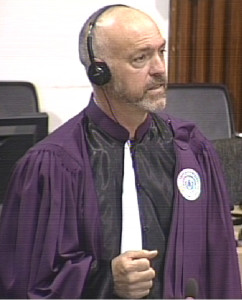
International Co-Prosecutor Nicholas Koumjian
Kang Meas and Steung Trong district, which did not belong to the East Zone but of the Central Zone, were also subject to the purge. “So it seems that it was nothing to do with the purging policy from the Central cadres” about the East Zone, but rather a general attack on Cham people.
Mr. Koumjian wanted to know whether there was any organized Cham resistance between 1977 and 1978. He answered that the Cham people did not have the opportunity to organize any rebellion.
Plan to smash the Cham
Turning to his next topic, Mr. Koumjian said that Ben Kiernan had written that twenty Cham families were deported somewhere and never returned. The person Kiernan relied on referred to a 1978 document called 163, which indicated that all Cham people had to be killed, since Cham people had already rebelled beforehand.[1] Mr. Koumjian asked whether Mr. Osman had heard about this document or a similar document during his research. Mr. Osman replied that one of his interviewees (Sos Kamry) had claimed that he read such a document in Chamkar Leu setting out a plan to kill all Cham before 1980. However, he had not heard of the document in question as such. He confirmed that this corresponded to what he had written in his book.[2]
Mr. Koumjian then asked about the interviewee Saleh Ahmat. Mr. Osman said that he was one of the people “who provided me with the information”. This person had recalled that Ke Pauk had said that the plan was to smash all of the Cham people, “because they were the traitors”. The name North Zone was used synonymously sometimes. At some point, the “Southwest Zone cadres invaded the North Zone”, and changed the name to Central Zone.
Mr. Koumjian then referred to the testimony of Ke Pauk’s son – Ke Pich Vannak – who had talked about the floating of corpses in the Mekong River.[3] Mr. Koumjian wanted to know whether anyone of the people he had interviewed while working at DC-Cam had talked about corpses floating in the river at Krouch Chhmar. He answered that it was correct, since the Cham people were gathered “for the purpose of purging”. The burial site was not big enough for all the bodies, which is why they were dropped into the river. They were tied together and then drowned in the river, after which the Khmer Rouge would untie them and drop them into the water.
Mr. Koumjian then wanted to know under which Zone commander Kampong Siem was in 1977. He answered that it was in the Central Zone in 1977.
Mr. Koumjian then referred to the “Livre Noir”, which indicated that Khmer Rouge officials or individuals had claimed that the Cham race was totally exterminated by the Vietnamese centuries ago.[4] After an objection by Khieu Samphan Defense Counsel Anta Guissé, Mr. Koumjian repeated his question. Mr. Osman said that the Vietnamese indeed had exterminated the Cham and “swallowed” Champa as a whole. During the Khmer Rouge regime, the Vietnamese had “no opportunities” to kill the Cham people.
One interviewee of Mr. Osman had talked about the killing of Cham children.[5] Mr. Koumjian wanted to know whether this was the only person who had talked about the killing of Cham children. He answered that the killing of children also happened elsewhere. He cited one of the Khmer Rouge slogans: “When you dig out the grass, you had to dig out all the root” When the parents were considered enemies, the children were also killed. Some children were spared if they were no longer identified as Cham. Mr. Osman explained that the unit chiefs might feel sympathy for Cham children and report to his superiors that there were no Cham children in his unit.
Religious leaders
Next, Mr. Koumjian read out the numbers as indicated in Mr. Osman’s book Oukoubah (on page 119) that showed the change of numbers of Cham leaders.[6] He wanted to know what a toun was (the number had changed from 300 in 1974 to 38 in 1979). Mr. Osman answered that a toun was a religious teacher. In every village, there had to be at least one toun. The Cham parents had to send their children to the religious school. Mr. Koumjian further asked what the role of a hakim was in a village.
Mr. Osman corrected the number that he had heard (130) to the actual number of 113. He then answered that his task was the general supervision of religion in a community. There could only be one hakim in a village. He was responsible for supervising villagers. “If anyone breached the religion”, the hakim was responsible for guiding them to practice along their religion. The hakim also decided who would become a toun. The mufti had superior authority and had to appoint the hakim. However, after 1979, there was no mufti yet, so the villagers voted who would be the hakim.
Mr. Koumjian apologized if he had made a mistake regarding the number, saying “must be getting old”. At the present time, there is only one mufti in Cambodia, according to Mr. Osman, but that mufti has several deputies. He had mentioned the students who studied overseas, since this was a rare opportunity for the community. They absorbed knowledge from other countries. Mr. Osman said that they needed a leader, since they were the minority. When losing the religious leader, the young students could not study religion in depth.
Mr. Koumjian then wanted to know how important it was for Cham people to live concentrated in one area in order to maintain their identity as such. Mr. Osman said that it was necessary that the Cham lived close to each other. The religion encouraged the people to live close to each other, since it was “necessary to help each other in case of emergency needs” and to “pray together in the mosque”. There should be a minimum of forty persons to pray in a mosque. However, they could also pray privately with fewer people.
Religious leaders
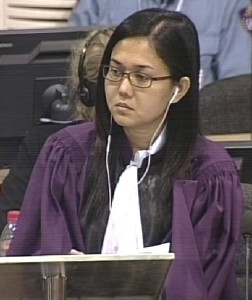
National Deputy Co-Prosecutor Song Chorvoin
After the break, the National Deputy Co-Prosecutor Song Chorvoin inquired about the educational system. He answered that the religious teachers (tuon) received wages from the villagers and the hakim had to ensure that these wages were paid. Students were sent to pagodas and taught by monks. Thus, they would know about Buddhism. Some villages had religious schools, while others did not. Those who did not would study at the houses from the tuon. In 1973, “the Islamic religion was closed”, when the mosques were closed and no religious leaders existed anymore. After the rebellion in Svay Khleang and Koh Phal, the Cham people were evacuated and dispersed. They no longer formed a big community. However, they taught “in cover” in the Cham communities, but the “complete shutdown” took place after the rebellion.
Between 1977 and 1978, the “Cham people assimilated with the Khmer people”, which made it difficult for the Khmer Rouge to differentiate between the two groups. Some children even had difficulties speaking Cham. They then “used a trick” and told them that the country had liberated and that they should return to their home villages to reunite with their families. Thus, it was easier to identify them. When they were gathered, they had to tell the Khmer Rouge whether they were Khmer or Cham. Those who indicated that they were Cham or half-blood were taken away and killed. He learned about this from a survivor in Trea Village. In his research, he relied on the accounts of survivors and perpetrators. Sos Kamry told him about a document that indicated that Cham people had to be killed. Also some Khmer people had said that they had seen such written instructions.
He recounted that a Cham person called Him Man and his wife fled when the Cham villagers were rounded up and brought to Wat O Trakuon to be killed.[7]
He did not know “why they did what they did. Why, after the Cham actually forfeited their religion […] and adapted the way they wanted”, why were they still killed? “And if I were to die, I would die without peace”, Mr. Osman told the Court.
He further explained the Court how survivors suffered traumata, since they had lost their families and were prohibited from practicing their religion. At this point, Ms. Chorvoin finished her line of questioning.
Questions by the Civil Party Lead Co-Lawyer
The floor was given to the Civil Party Lead Co-Lawyers. Marie Guiraud asked whether he could give an estimate of the number of interviews of Cham people that he had carried out since he started working on this matter. He replied that he did not count the number of interviewees. He commenced his interviews in 1998 and had interviewed around 200-300 people. The majority of these were Cham people. A small number of interviewees were Cambodians. He divided these in two groups: group one were victims who lived with the Cham people and also suffered in a similar way. The second group consisted of the perpetrators. For his Oukoubah book, he did not focus on one particular area. Instead, he focused on the Cham victims.
Ms. Guiraud said that he had said that most of the Muslims in Cambodia were Cham and wanted to know what other minority existed. Shia were also considered Cham.
She asked whether there were other criteria than language and clothes to define a Cham community. He answered that it were simply areas where around forty or fifty Cham families were living in one village. This was a Cham community. He used the word community for an ethnic minority in a country. As for the sense of solidarity, he said that if a child lost his or her parents, the community had an obligation to take care of the child. The same applied to poor people. By the end of 1975, “no solidarity existed. The Cham people could not help one each other. Each of them had to try their best to save his or her own life.”
Small groups were formed around the so-called Chum Ah.
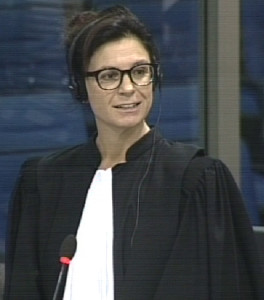
International Lead Co-Lawyer Marie Guiraud
She then wanted to know whether there were other people who were in charge of educating the young people and teaching religion beside the tuon. He said that different people tried to bring knowledge to Cham people, as he himself did, for example. Ms. Guiraud inquired about the importance of the family in Cham culture. He answered that regarding the history in the family, parents taught the oral history to their children. The cultural aspect of the Cham was intertwined with the religion. “History can disappear, because there is no written record”. The written records perished, since the material was “burned down” or buried, but with those having passed away who buried the material. Some people ploughed a field and found such materials in the field. “If there had not been the Khmer Rouge regime”, the conditions of the Cham community would not have been like it was today. It would be “more prosperous”, he said, “and more glorious.” Ms. Guiraud wanted to know whether the separation of families had an impact on the Cham community. He answered that “the separation severely affected the Cham people”. The Cham people could no longer speak Cham. “They lost their identity” as a result of their separation, since they could no longer listen to the history of the Cham from their parents.
Turning to her next topic, she inquired whether Cham people worked the fields differently than Khmer people. Mr. Osman said that the Cham people had special skills, for example with regards to fishing. “The Cham people knew how to sustain the number of fish in their fishing”. Another skill was blacksmithing.
Ms. Guiraud further asked whether the collectivization had an impact on the Cham villages and communities. He answered that the collection not only took place with the land, but also with people. Since everything became collective property, they could not eat the vegetables on the field. He confirmed that there were communities that consisted only of Cham people before 1975. From November 1975, the Cham lived together with the Khmer people in the cooperatives. As for eating, the Cham people could only eat chicken and beef when they were killed by Islamic traditions. When living in the cooperatives with the Khmer people, they could no longer maintain these practices and had to eat commonly with the Khmer people.
Marriages and customs
After the break, Ms. Guiraud asked whether a Cham could pray in Khmer. Mr. Osman replied that there were two kinds of religious practices. One way was to pray in the Arabic language which could not be translated. It was part of the Qur’an. However, “if you pray for harmony or peace from Allah”, other languages could also be used.
Ms. Guiraud then inquired what types of texts were buried and where these had been found. He recounted that a villager in Svay Khleang found them while plowing his field. They were religious texts in the Arabic language, some of them handwritten.
The “clear instructions by the Khmer Rouge” was to burn religious texts, in particular the Qur’an. This corresponded to one of the five conditions that he had mentioned yesterday. The hid the texts when they heard about this rule. He believed that there were more texts that are hidden in the ground.
He said that “praying is one of the obligations of the Islam” as part of one of the five obligations as a religious believer. If failing to do so, this person could not be regarded as an Islamic believer. They would “usually have to pray five times per day.” If parents did not have time to teach the children, they would send their children to the tuon who would teach them how to pray in the Arabic language.
Ms. Guiraud then read out a part of the testimony he gave yesterday and asked him to explain how marriages in Cham communities were organized prior to the arrival of the Khmer Rouge. At this point, National Khieu Samphan Defense Counsel Kong Sam Onn interjected and said that she had misinterpreted his statement. She said she did not understand the objection, but still rephrased the question and asked what the practices were before Democratic Kampuchea. He answered that there was no restriction that an Islamic believer had to marry another Islamic believer – as long as the other person converted to Islam. The 5th condition imposed by the Khmer Rouge was that Cham men and women had to marry Khmer women and men respectively. However, this was not implemented, since the Cham people were evacuated and lived mingled with the Khmer people.
From late 1975 until late 1978, they did not dare to oppose any instructions with regards to marriage, for example. If they were to marry a Khmer person, they would do so.
Late appointment of a mufti
Ms. Guiraud then inquired whether she properly understood his testimony that there was no mufti after 1979 and that the villagers appointed the hakims subsequently. He confirmed this. Later, when a mufti had been elected, this mufti would choose the hakims and the villagers were not involved in the process anymore – unless the villagers were not content with the appointment and wanted someone else to be appointed, in which case the mufti would usually consent to the will of the villagers. The first person who attracted most votes would become mufti. Another mufti would be elected after the expiration of his office terms. The second mufti did not have any expiration day of his terms of office.
Ms. Guiraud asked why it took so long to appoint the new mufti, who was only elected in 1993. He answered that not all freedoms could be exercised until that time. He further recounted that he referred to the government after 1995 and did not mean that the government killed the group or prohibited them from practicing their religion. However, the communication between Cambodia and other countries was still restricted when he was growing up. Thus, the government organized the structure. There was no mufti yet, although there were hakims and tuons.
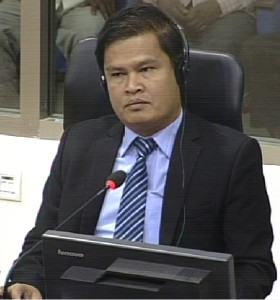
Expert Ysa Osman
Ms. Guiraud asked whether he had personal recollections of what happened during the rebellion in Svay Khleang, pointing out that decision allowed them to ask this question.[8] He said that he was only four years old at the time and could not remember. He answered that many of his relatives lost their lives in the rebellion. His grandparents were told to leave the village but refused to do so. “They said this is our house, our village”. In 1979, when his family returned, those who had refused to leave (such as the elderly and the pregnant women) were not there anymore. His family was sent to Kratie. In Kratie, none of his family members were subject to any mistreatment, except of being forced to eat pork. In 1976 one of his older brothers died out of starvation. In 1978, one of his younger sisters died in a hospital in Kratie. He remembered well the starvation, since he could recall needing more food. His parents tried to appease him. The children were collecting left-over fruits and food. His father was separated from his mother. They were living far away from each other. His sister was living with his mother, but when his mother left for the dam worksite, his younger sister was sent to a children group supervised by “an old lady”. His younger brother, who had died in 1976, was sent to a unit far away from his. Mr. Osman himself could not meet his father or his brother.
He kept waiting to see the return of his uncle, his aunts, his cousins, his second cousins, but even after two or three years, no one returned. He therefore assumed that they had died or killed. In 1979, most of the houses were empty, although the village had been large before. If she wanted further details, she would have to do research in the village. With this, Ms. Guiraud finished her line of questioning.
Questions by Judge Jean-Marc Lavergne
Judge Jean-Marc Lavergne had a few questions. He referred to an original copy of a telegram that is mentioned in its totality in the book written by Mr. Osman (the Cham Rebellion, page 166).[9] The rebellion took place before the one mentioned in the document in question (called Telegram 15), namely in October 1975 in Koh Phal, which corresponded to the 30th of the Ramadan month. The villagers remembered this very well according to Mr. Osman, since this was the end of Ramadan. A person called Chhon was mentioned in the document. Mr. Osman did not know who Chhon was. The document did not indicate whether the rebellion took place in Koh Phal or Svay Khleang.
Mr. Osman said that Cham people were dispersed, since the Khmer Rouge feared that there would be another rebellion if the Cham people were allowed to stay. Mr. Koumjian interjected and said that there had been a translation error. A new document had been on the case file and another translation requested.[10]
The telegram was addressed to Brother Pol, but there were other recipients as well. Judge Lavergne wanted to know whether he could give more detail on account of these recipients. Mr. Osman answered that he could not find the minutes of the discussion that this telegram was based on.
As for the evacuation, it took place after the meetings, which were called after the rebellions. “During the meetings, the Cham people were warned not to rise up.” Some of the people who were evacuated “were not received” and were sent to other places. Brother Nuon, which he understood to be Nuon Chea, also received the telegram, as did Comrade Pauk. Comrade Pauk was mentioned in the third paragraph, Mr. Osman said.
Judge Lavergne wanted to know who the leaders were of Tbong Khmum District, since he had said that it was detached. He answered that part of Tbong Khmum was in another district, but it was not detached from the river bank. Mat Ly was one of the leaderships of Tbong Khmum, but he said that “it was unlikely” that he was the secretary.
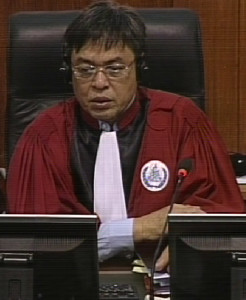
Trial Chamber President Nil Nonn
Judge Lavergne referred to another telegram mentioned in The Cham Rebellion (on page 115), which also existed in several translations. It was also a telegram. Judge Lavergne pointed to different translations and asked whether he had been able to check his translation again.[11] Mr. Osman compared the different versions and said that it seemed like there was a gap in the version in his book. In fact, the document was also mentioned to Nuon Chea and Khieu Samphan. He did not mention in his book that Brother Khieu meant Son Sen, and not Khieu Samphan.
Saying that Ben Kiernan had referred to interviews, Judge Lavergne asked whether Mr. Osman had access to those documents that Kiernan relied upon.[12] He said that he had read Mr. Kiernan’s book. He then said that the events in 1978 were “the worst”, even in other zones.
At this point, the Trial Chamber President Nil Nonn adjourned the hearing for a break.
Relationship between Khmer and Cham people
After the last break, the floor was again given to Judge Jean-Marc Lavergne. He asked what possible impact of the conflict with Vietnam was on the treatment of the Cham. Mr. Osman said that these were two separate events. Mr. Osman then acknowledged “the gap” between the two versions. He “admitted” that there were discrepancies between the English translation and the Khmer original.
Judge Lavergne then referred to Nate Thayer, who had interviewed Pol Pot, and who had also interviewed Cham people. Mr. Osman said that he had also read this document. He said that there could be “differences in the treatment”, for example with regards to the requirement to eat pork. A small number of Cham people were assisted by village and cooperative chiefs when these had sympathy for the Cham people. Cham people would also support Khmer people and, “despite the policy to mistreat the Cham people and to kill the Cham people”, some Khmer people helped the Cham people. Some of them “became godfathers or godsiblings” due to this closeness.
Judge Lavergne wanted to know whether there was also a culture of mistrust between Khmer and Cham people beforehand. For example, Vickery had stated that some Khmer people were afraid of Cham people, since they believed that Cham people were involved in witchcraft. Mr. Osman replied that he had heard this and that this was a form to disgrace the people. He had even heard worse than this, for example that it was said that if a Khmer person drowned, a Cham person had killed that person. However, in general, they were more “like siblings”. He stressed that this occurred on an individual level.
Turning to his next topic, Judge Lavergne asked what access he gained to documents regarding S-21. Mr. Osman replied: “I read many biographies, confessions, and correspondences.”
Judge Lavergne asked whether there was information about a policy targeted specifically at the Cham in these confessions, for example. Mr. Osman answered that none of the documents from S-21 mentioned that the Cham had to be purged. He said that S-21 was the detention center for so-called important persons, such as former Lon Nol officials or even high-ranking cadres. “Ordinary people were seldom sent to S-21”, since they could be killed right away in the communes they lived in. This was reflected in the small number of Cham people who were detained at S-21.
Judge Lavergne wanted to know whether being a Cham was “a handicap” when wanting to become a Democratic Kampuchea soldier and whether there were many examples of cadres who were high-ranking soldiers in Democratic Kampuchea. Mr. Osman said that some Cham people worked on the communal level, such as Mat Ly.
Judge Lavergne inquired about the person Les Kosem. Mr. Osman said that he was in Brigade 5 and originally came from Kampong Cham Province. The Lon Nol government wanted Cham people to be in the government, which is why some Cham people held high ranks in the police and the Parliament.
Judge Lavergne said Michael Vickery had said that Brigade 5 was divided into smaller units and asked for a reaction.[13] Mr. Osman answered the following: “allow me to be frank here. I did not conduct a thorough study of that brigade”
Judge Lavergne then referred to the recently admitted WikiLeaks document that indicated that Lon Non (Lon Nol’s brother) had said that more Cham soldiers would have been beneficial.[14] The expert said that he had not heard of this telegram. He denied that the Khmer Rouge wanted to take revenge for Cham being part of the Lon Nol government, since they would have “killed them right away”. Only a small number of Cham people took part in the Lon Nol government. He made a distinction between Cham people who lived in the rural areas and those who lived in the urban areas. Mr. Osman confirmed that those in the urban areas were more likely to support the Lon Nol government. Moreover, the Lon Nol government did not suppress the Cham, according to the witness.
FURO Movement
He confirmed that he heard about the so-called FURO movement. He had heard about this from his father. Someone called Ibrahim talked extensively in his confession.
Judge Lavergne then wanted to know whether he had heard someone mentioned that FURO was a reason to target the Cham. Mr. Osman said that his family had told him about the movement that wanted to “regain our territory”. It had two aims: one, to regain Champa. Second, to regain Kampuchea Krom from Vietnam. He heard that Lon Nol was the chief of the FURO movement to liberate Kampuchea Krom. Someone else was responsible to regain the Champa territory. They conducted warfare with Vietnam. “But unfortunately, Cambodia faced civil war from 1970, and as a result, FURO had no more activity. And FURO movement therefore changed its direction to [fight] against the Khmer Rouge”.
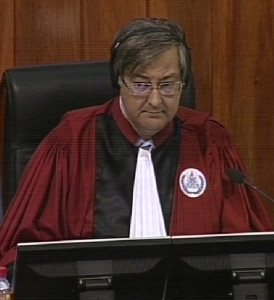
Judge Jean-Marc Lavergne
The history of the FURO movement “never wanted to capture Cambodian territory and create the Champa state”. The movement itself was supported by the Cambodian government. Thus, “there was nothing related to the Khmer Rouge policy of the treatment of the Cham people. In fact, the Khmer Rouge should have supported this movement, because the Khmer Rouge [themselves] wanted to fight against the Vietnamese. FURO movement did not contradict with the Khmer Rouge goals. So, the Khmer Rouge should have supported this movement.”
Judge Lavergne then referred to the Constitution of Democratic Kampuchea, Article 2 which stipulated that “All Kampuchea citizen have the right to practice their religion” but that “reactionary religion” was to be prohibited.[15]
When Judge Lavergne inquired about reactionary religions and the understanding thereof, Mr. Osman answered that religions led people to “do good things”.
Judge Lavergne wanted to know whether anything was mentioned with regards to ethnic minorities. Mr. Osman said that if looking at the identity card, no distinction was made between Khmer and Cham people. Judge Lavergne wanted to know whether there was a meeting to discuss a policy with regards to religious minorities, such as the Cham. Mr. Osman said that he did not remember reading such a document. With this, Judge Lavergne finished his examination.
At this point, the President adjourned the hearing. It will resume on Tuesday, February 23 2016 with the key document hearings that will continue until the 25th, meaning that Ysa Osman’s testimony will continue on the March 2 2016. Next week, the Supreme Court Chamber will hear the appeal hearings on Tuesday, Wednesday and Thursday.
[1] E3/1593, at 280 (EN), at 00639054 (FR), 00637796-97 (KH).
[2] Ysa Osman, “The Cham Rebellion”, p. 116; E3/2653, 00904363 (KH), 00943975 (FR), p. 116 (EN).
[3] E3/35, at 00340567 (KH), 00367727 (FR), 00346155 (EN).
[4] E3/266, at 00289650 (KH), 00284574 (FR), 0082514 (EN).
[5] The Cham Rebellion; p. 148 in English, 00904406 (KH), 00219209 (EN), no French translation available
[6] Oukoubah; E3/1822, at 00758331 (FR).
[7] This person testified in Court. See http://www.cambodiatribunal.org/2015/09/17/cham-civil-party-describes-survival-of-mass-killings/ .
[8] E367
[9] E3/154.
[10] E3/1679 and E3/154/1 correction 1.
[11] E3/511, 00350762 (FR); E3/952, at 00182658-60 (EN).
[12] E3/1593, at 01150147 (EN), 00639052-53 (FR), 00637796 (KH), p. 280.
[13] E3/1757, at 00337271.
[14] E367/5.1.6, at 01199963 (EN).
[15] E3/259.
